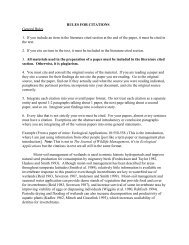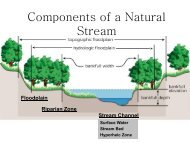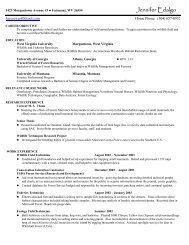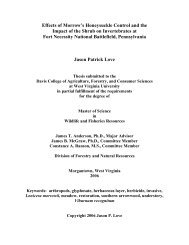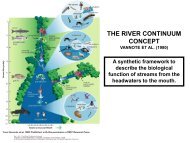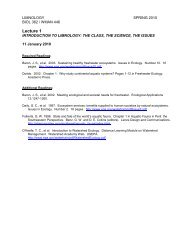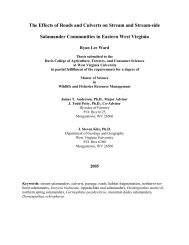An Experimental Study of Vertical Habitat Use and Habitat Shifts in ...
An Experimental Study of Vertical Habitat Use and Habitat Shifts in ...
An Experimental Study of Vertical Habitat Use and Habitat Shifts in ...
Create successful ePaper yourself
Turn your PDF publications into a flip-book with our unique Google optimized e-Paper software.
alteration may reduce the habitat suitability essential for native species (Moyle 1986),<br />
especially those sensitive to factors such as turbidity (Gilbert 1969a, Eisenhour 1995).<br />
Rapid eutrophication was cited as a factor reduc<strong>in</strong>g the abundance <strong>of</strong> two native Notropis<br />
species <strong>in</strong> a lotic environment (Hartman et al. 1992). Introduced species could capitalize<br />
on released niche availability if they can survive <strong>in</strong> the host environment. Stream<br />
turbidity has even been hypothesized to pose problems <strong>in</strong> mate recognition that may lead<br />
to hybridization with congeneric species (Eisenhour 1995).<br />
Review <strong>of</strong> <strong>Study</strong> Area/Related Studies<br />
Available <strong>in</strong>formation is summarized concern<strong>in</strong>g the species, watersheds, <strong>and</strong><br />
similar studies for that which this review was conducted. Although the study discussed<br />
<strong>in</strong> Chapter 2 was designed to observe potential <strong>in</strong>teractions which can occur between<br />
native <strong>and</strong> nonnative species, the focal species were selected from the New River<br />
dra<strong>in</strong>age (specifically from the upper Greenbrier Watershed).<br />
The New River system conta<strong>in</strong>s a relatively large number <strong>of</strong> endemic <strong>and</strong><br />
<strong>in</strong>troduced species (Hocutt <strong>and</strong> Hambrick 1973, C<strong>in</strong>cotta et al. 1999, Wellman 2004,<br />
Hocutt et al. 1978). Dra<strong>in</strong><strong>in</strong>g approximately 17,918 km 2 the New River flows through<br />
the states <strong>of</strong> Virg<strong>in</strong>ia, North Carol<strong>in</strong>a, <strong>and</strong> West Virg<strong>in</strong>ia (Stauffer et al. 1995). Parts <strong>of</strong><br />
the Blue Ridge, Ridge <strong>and</strong> Valley, <strong>and</strong> Appalachian Plateau geographical prov<strong>in</strong>ces are<br />
transected. Several species are endemic to the upper New River system (Hubbs <strong>and</strong><br />
Trautman 1932, Hocutt et al. 1978, Jenk<strong>in</strong>s <strong>and</strong> Burkhead 1994). These <strong>in</strong>clude the New<br />
River sh<strong>in</strong>er (Notropis scabriceps), the Kanawha darter (Etheostoma kanawhae), the<br />
Kanawha m<strong>in</strong>now (Phenacobius teretulus), the Appalachia darter (Perc<strong>in</strong>a<br />
16



